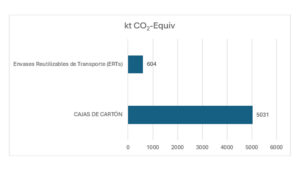Replacing cardboard boxes with reusable plastic containers would reduce 4426 Kt CO2 annually in the packaging and retail phase in Spain
2024-02-07
Guaranteeing enough food for the growing world population, while reducing impacts on the environment, is one of the main challenges of the 21st century (UN, 2015). Food systems are responsible for 23-42% of global greenhouse gas (GHG) emissions (IPCC, 2022). Overall, GHGs before and after agricultural production reached 5.5 billion tons of carbon dioxide equivalent (Gt CO2eq) globally in 2020, 33% of emissions from agri-food systems (FAO, 2023).
Image
The food chain generates GHG in all phases which includes, after agricultural production, processing, packaging, transportation and retail. Based on the FAO in 2021, the proportion of post-agricultural production emissions related to packaging and retail in Spain is approximately 12% and 15%, respectively (FAO, 2023).
In this sense, packaging could play an important role in reducing GHG emissions in the retail and packaging phases. To achieve this, it is necessary to calculate GHG emissions throughout the life cycle of different types of packaging.

This is where Life Cycle Analysis (LCA) plays an essential role. In this sense, the UNESCO Chair of Life Cycle and Climate Change ESCI-UPF has carried out a study to calculate the environmental impacts, associated with the distribution of fruits and vegetables in the Spanish internal market (peninsular), by comparing two solutions packaging: disposable cardboard boxes and Reusable Transport Containers (ERT). The study includes the complete life cycle of both distribution systems, considering the stages of extraction of the raw material for the manufacture of the boxes, the production, distribution and use process, and the recycling or final deposit in a landfill or incinerator. after its useful life. The extended functional unit used in the base scenario is the distribution of 1,000 tons of fruits and vegetables, with a transported weight of 15 kg per box, in cardboard boxes (single use) or ERT with 10 years of useful life and 10 rotations. by year. According to the results of the study, ERT have a lower carbon footprint (88%) than single-use cardboard (BALA and FULLANA, 2017).
According to FAO data from 2023, in Spain 27% of greenhouse gas emissions from post-agricultural production, which is equivalent to 5,030.50 tCO2 Equiv., come from packaging and retail. Assuming that only cardboard boxes were used for packaging and that they were replaced by ERT, we could achieve a reduction of 88% ( Fig 1 ). This translates to around 4,426 Kt CO2 Equiv. annual reduction in the packaging and retail phase in the post-agricultural production phase in Spain.

Fig 1 : Annual greenhouse gas emissions in the packaging and retail phase of the supply chain: cardboard box versus ERT.
Therefore, the transition from cardboard boxes to RPC boxes throughout the supply chain has great potential to reduce the carbon footprint and promote sustainability.
In addition to greenhouse gas emissions, another impact of packaging in post-agricultural production is the generation of waste. Between 2009 and 2020, the total mass of packaging waste generated in the European Union increased by 20% (EU, 2023). In the LCA carried out by the UNESCO Chair on Life Cycle and Climate Change, it has been considered that 100% of the damaged ERT boxes that are identified in the inspection stage are sent to a recycler (according to data provided by Euro Pool Systems , IFCO and Logifruit) and that these are made from 100% virgin material. As for the cardboard boxes, it has been considered that they are made with 20% recycled material (according to FEFCO data for the CF1 reference) and that at the end of their useful life, 80% are recycled and used again in the manufacturing of new boxes and that the remaining 20% are incinerated in a facility with energy recovery.
According to the Packaging and Packaging Waste Directive, European Union Member States must prevent the generation of packaging waste and minimize the environmental impact of packaging. They must also take measures to increase the proportion of reusable packaging placed on the market and implement packaging reuse systems, without compromising food hygiene or consumer safety (EU, 2023). In this sense, and to achieve the objectives of this regulation, the use of ERT is better from an environmental point of view. Not only due to the reduction of packaging generated, but also due to the reduction of the impact associated with the distribution stage.




